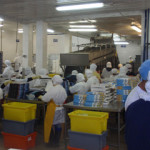The current Sino-U.S. trade war, which has seen tariffs imposed on most seafood products from China, is causing many seafood processing companies in China to reassess whether or not to move their operations out of the country. This is the second of a two-part series looking into the issue. Part one, "Is trade war pushing seafood processing out of China?" was published on Monday, 30 July.
SeafoodSource conducted a rudimentary if revelatory experiment recently, taking out the exhibitors’ handbook from the 2012 China seafood fair (Dalian) and leafing through the pages listing processors before calling some of them. The calls revealed more than half of the 50 companies listed from across China were out of seafood processing, but only two firms were out of business.
Firms that once relied on export markets and contract processing have turned into importers. One of China’s leading offshore fishing companies, CNFC, has scored marketing success with its premium shrimp from Madagascar sold under its “Zhong Shui Yuan Yang” brand. State-owned CNFC has worked hard in recent years to establish its own brands of premium imported seafood for the Chinese retail sector. Elsewhere, numerous Hainan-based tilapia processors have signed supply deals with local fish hot-pot chains, which are currently all the rage in China. Meanwhile, Guangdong-based shrimp firm Guolian Aquatic has built giant kitchens to cook and crumb shrimp for domestic convenience stores and diners.
In most cases, Chinese processors have been adapting their capacity to local markets, often in cooperation with local retailers and convenience store chains. The ongoing explosion of franchised fast-food restaurants in China has been a feature of recent years and opens up huge opportunities for processors finding their export markets challenging in terms of tepid margins and currency risks given the increased strength of the yuan (which has marginally softened in recent months, but is unlikely to sink significantly against the dollar).
It’s clear that the domestic market is where the action is. China’s exports of goods and services as a percentage of GDP sunk from 34.9 percent to 18.5 percent between 2007 and 2017, a remarkable slide that underscores the power of the local market.
But that doesn’t mean China isn’t exporting cheap, processed seafood. While driving up wages, the Chinese government has also sought to increase productivity and mechanization while pursuing the “One Belt, One Road” initiative (or Belt and Road Initiative) to bring regional markets into China’s embrace as suppliers of raw materials and buyers of Chinese processed products. The idea is to improve productivity, not to get rid of manufacturing and processing with China’s huge factory capacity supplying a vast region of buyers more easily than before.
And while it has been evident for some time that China wants out of low-cost manufacturing, that doesn’t mean it wants to exit food processing altogether. Rather, it wants to convert itself into a lean, modern manufacturer of value-added goods.
Achieving that will help the country pay for the more comprehensive social safety net that it has long promised to its people. Mending and extending pension and health insurance systems will require greater social insurance costs in workers’ pay, which could drive wage costs up by another 40 to 50 percent this decade. The lack of healthcare coverage and retirement benefits in many of China’s regions has held back the government’s shift towards a consumption-driven economy, so this will likely happen.
It’s important to note that China’s rising labor costs – average annual manufacturing wages rose 80 percent since 2010 – are not coincidental. Rather, they are the direct result of government policy. The 12th Five-Year Plan, after all, called for a 13 percent annual increase in the minimum wage nationwide – in turn driving up incomes and spending.
Even if it continues to get more expensive for labor-intensive processing, China’s market is still too enticing for many processors to let go. Few Southeast Asian markets, save perhaps India or Indonesia, have the kind of domestic market that China offers. The Association of Southeast Asian Nations (ASEAN) has a combined population of more than 600 million, which makes it a large market, but the bloc remains far from a European Union-style single market. Crossing borders remains bureaucratic by contrast to the European model. Better to stay in China, with its 1.4 billion people and still-rising incomes and consumption power.
Bringing workers into the country may be more of a trend for the future of China-based seafood processing than moving plants out. China’s long-time unwillingness to open its doors to manufacturing labor may be changing. Certainly the city of Hunchun on the North Korean border has become an unlikely land-locked seafood processing hub due to its ability to hire North Korean workers at a fraction of the cost of Chinese staff. The proximity to a Russian port also helps ensure efficient inward transport of raw materials.
The Hunchun model could work in southern Chinese provinces like Guangxi, on the border with Vietnam. There have been attempts in southern China to create similar border processing zones with Vietnamese labor, though those efforts haven’t been warmly received by the government in Hanoi.
The troubled border with Burma already sees a flow of informal Burmese labor working in China, but the province of Yunnan on the Chinese side is sparsely populated and remote in comparison to the key processing and logistics centers like Guangdong Province.
The bottom line appears to be that China may be losing its competitiveness as a manufacturing base, but the lure of its enormous and growing market is enough to make most manufacturers stay put. Who wants to leave China when future sales depend on its huge market? Most firms appear to be staying put.
Photo courtesy of Dongfeng Daily






